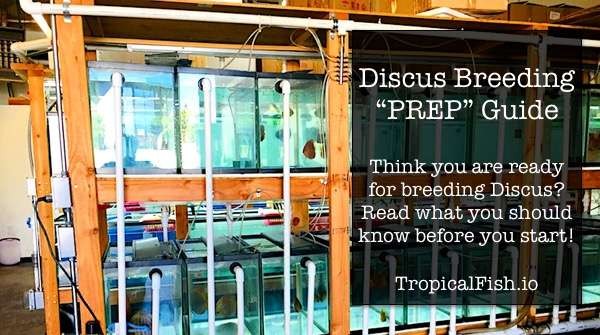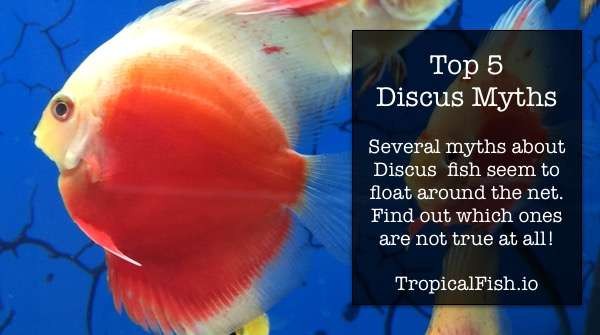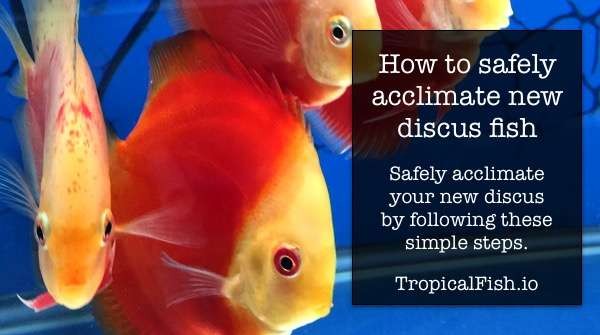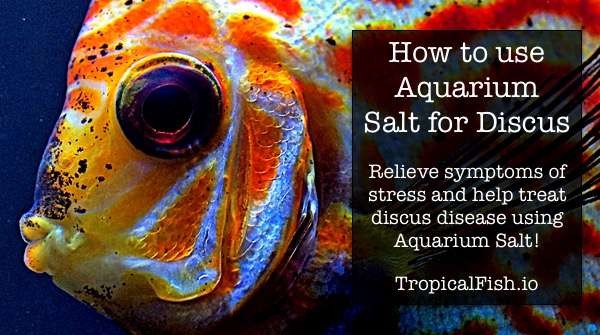Discus Fish Breeding Guide
( What You Should Know Before Starting )

Here are some tips to getting your discus fish ready to begin breeding. Sometimes it can take all of these steps, sometimes it's just one or two small changes to get it right. Discus are very special when it comes to breeding, having their own mating rituals including the shimmy and bowing to each other.
Grow out your Juveniles to Adults
Let Discus breeding pairs form naturally
Feed protein rich food
Keep water clean and acidic
Provide clear vertical surfaces
Prepare breeding tanks
Move proven breeding pairs
Let Nature Take It's Course
Grow out your Juveniles to Adults
Unless you are starting with a proven pair, most start with several smaller juvenile discus purchased in large groups and placed in a large tank. Buying proven pairs leap frogs you past several steps, but it comes with a large price tag. Proven breeding pairs typically will sell between $200 and even beyond $1000+ for rare color variations.
If you do not have deep pockets and want to get the most discus you can for your money, most start with buying smaller juvenile discus. Growing out juvenile discus is no easy chore, it can take several months and up to a year or so if you buy small coin sized discus. You will experience some losses as natural selection does happen and rarely do all fry survive into adults.
Keeping the water clean and frequent feedings is critical to strong development and growth. Legendary Discus breeder [Jack Wattley](https://wattleydiscus.com/ experimented with 100% water changes on smaller tanks several times a day on test tanks. Compared to tanks with fry from the same batch who's water was changed less frequently. The discus in the tank with the frequent 100% water changes grew out faster and larger than their siblings who received fewer frequent water changes. According to Mr. Wattley, same water and food was used plus feeding frequency remained the same. The only change was the amount of water changes per day.
The lesson, water changes are VERY important in growing out your discus as large as possible and keeping them as healthy as possible. Keeping water on stand by in a container for frequent water changes will help keep water stability and make frequent water changes easier. For example, if you have your tanks in the garage or a fish room, keeping extra water in a 50 gallon trash can with an airstone and heater will make water changes faster and easier.
Healthy discus grow out requires, water changes, high protein food and stabile water parameters.
Let Discus breeding pairs form naturally
You can't rush it, discus fish select their partners when they want not when you want. To improve your chances of growing out discus that will pair up, it is best to get 10 or more in a larger 65 to 100 gallon tank.
Assuming you are dealing with larger 5 to 6 inch larger juvenile or adult discus, providing enough space to swim an bond is critical. Typically you would want a bare bottom tank, meaning no gravel or decorations in the tank. Keeping the tank bare provides maximum swimming area as well as prevents injury to discus who tend to jet around the tank.
Four things to look for and spot discus who are pairing up...
The Shimmy
Discus that are ready to pair up begin to openly shimmy or shake in order to let others know they are ready to breed. Sometimes this behavior can be a bit aggressive if one discus is really trying to get the attention of a specific tank mate. The aggressive could include cornering a specific discus fish and shaking in front of him or her.
The Bow
Bowing is by far the most graceful of the breeding rituals. It starts with two discus fish who are pairing up swimming towards each other. As they get close to touching face to face, they immediately tilt downward in a "bowing" motion and continue to swim passed each other. They continue to do this, which in my experience tends to lead to stronger bonding and eventually leading to the next step.
Cleaning Vertical Surface
Next, if a pair forms, they may begin to peck at a specific area on the side of the tank or other vertical object, such as a filter tube or piece of wood or stone. What they are doing is removing algae and other growth, perhaps even making the surface more adhesive to better attach eggs.
Once vertical surface cleaning begins, the pair will become a bit more aggressive towards other discus in the tank. Protecting the area and chasing away other discus who swim to close. At this point you might want to begin preparing a separate tank, at least a 20 gallon tank to move your discus pair into. Don't move them yet, wait to see eggs and if the eggs hatch into wrigglers. Then and only then will you know if you have a viable pair.
Darker and Stripes
Not all, but in few cases pairing discus will show darker vertical stripes very prominently. Discus that are derived from Heckel will have a solid thicker bar down the center of the body. Mixed strains may still show narrow or thinner stripes and solid color discus may just become darker overall.
Feed protein rich food
Opinions differ when it comes to feeding discus quality high protein food. Some say beef heart, others frozen bloodworms and some will use live food like blackworms.
Before we get into what food to feed, let's understand why we are feeding a protein heavy food. Discus in the wild waters of the Amazon fed on large varieties of live foods. During the rainy season, water ways introduced rich sources of worms, insects and other live foods, creating a feast mode for discus. The rainy season brings freshwater, like a massive water change. As the water recedes an the rivers become acidic, healthy well fed discus begin to look for mates. This instinctual behavior, baked in to the genetics of discus, triggered by water chemistry and abundance of food is what we are trying to recreate.
Beef heart, at least in my experience, tends to muck the water. It is very fiberous, as it is muscle tissue and tends to spread around the tank and filter and decompose. This leaves two other options, frozen bloodworms or live blackworms.
Frozen bloodworms should be used as a secondary source of food next to live blackworms. Frozen bloodworms are easy to find at your local pet store and are affordably priced. Processed by trusted aquatic food manufacturers, frozen bloodworms offer very little to no risk of poor quality food.
Live blackworms, in my opinion, provide the best results in both growing out your discus and prepping them for pairing and breeding. [Aquatics Foods](https://www.aquaticfoods.com/ sells and delivers live blackworms directly to your home. If you ever want to see happy discus, feed them live food. Compared to flakes or pellets, live food drives discus into a feeding frenzy.
Nothing in my opinion, will grow out and get your discus ready to breed like live blackworms.
Keep water clean and acidic
Prepare to buy a solid performing Reverse Osmosis filter that will help you lower hardness of your water as well as clean out fine particles and chemicals from water that come out of your tap. Amazon carries a wide assortment of Reverse Osmosis units and you can daisy chain them to customize for your local water needs.
Since we can always go smaller, let's breakdown a larger 5 unit reverse osmosis unit:
Stage One
Polypropylene Sediment Filter: This removes dirt, rust and other small particles floating in your water that may or may not be visible to the naked eye.
Stage Two
Activated Carbon Filter: The activated carbon is used to remove harmful chemicals from the water that may have been introduced by your water provider or via contamination.
Stage Three
Coconut Carbon Filter: This will remove chlorine, odors and other nasty chemicals that may have snuck through, extra protection to assure water is as chemical free as possible.
Stage Four
RO Membrane: This removes up to 99% of total dissolved solids ( TDS ) from your water. Contaminates such as arsenic, lead, fluoride, chromium and just about everything else is trapped and removed from your water.
Stage Five
Deionization: The final stage removes anything else that is left, mostly minerals like calcium, iron, copper, sodium and more.
If you do use a five stage RO unit, you will end up with water very close to zero TDS which is not great as Discus need certain minerals in the water to survive and function. You will only end up putting those minerals back in to your water, so why remove them in the first place?
In my experience a three stage RO unity works great, using a sediment filter, a carbon filter and RO membrane gets my water between 60 to 90 TDS which is ideal for discus breeding.
A few extras that got me along the way, if you have low water pressure, you will need ro water booster pump. What this does is takes the water coming in from your source and pressurizes it, pushing it through your arrow system and increasing your filtered water output. For example, my water pressure was too low in my home and it would take all day to produce enough RO water for my discus tanks, after introducing a water booster pump, it only took an hour, maybe two. Boosters are worth their weight in GOLD!
The second gotcha is a TDS meter, if you don't have one, get one now, they are not that expensive on Amazon and you will begin to understand just how much stuff is in your water. I started testing everything with it, tap water, tank water, even daily drinks. It's amazing how many particles are in water depending on sources. Using a TDS meter will help you better determine when you will need to change tank water as well as when you will need to change filter media from your RO unit. RO unit water will begin to significantly increase as filters become less efficient and your RO unit requires maintenance.
Final tip would be to have standby container that can hold your RO water. I used a rubber maid 50 gallon trashcan, you can choose to use a back up fish tank or other container. I did a few things in order to keep the RO water ready for water changes.
Heater
I used a titanium heater with an external setting module and set the water temperature to match my tanks. This made sure I wasn't giving my discus the cold shower treatment every time I did water changes. It also gave me the ability to lower the temperature slightly to simulate the natural fluctuation of temperature caused by rain in the amazon to help induce breeding environments.
Peat Moss
Using a nylon cord bag, I would fill it with peat moss that would release natural tannins into the water, lowering pH and helping my water to become more acidic. Mimicking the brownish water of the amazon created by decaying leaves and other organic material found in natural discus environments.
Powerhead
A small powerhead was used to circulate water around to keep the water column at a constant temperature, didn't want the bottom water closer to the heater hotter than surface water. Second, it help pass water through the nylon mesh bag containing the peat moss.
Air Stone
Lastly, I used an air stone powered by an air pump to help increase the oxygen levels in the water as well as stabilize the pH. I noticed that RO water would gradually increase in pH if added directly to my tanks after water changes. This would have a negative affect towards my discus breeding goals. Using the air stone allowed for the natural increase in pH to occur before adding the water to my discus tanks, keeping water parameters more stable overall.
To recap, having enough water on standby to complete a 100% water change should be your goal. You never know what may happen and you do not want to get stuck having to wait or use non-filtered water.
Provide clear vertical surfaces
Discus will lay eggs on just about anything, it doesn't matter if it's a breeding cone, drift wood or a pink sparkly castle. What you want to do is provide clean and accessible surfaces for discus to tend to eggs.
Here are some reasons why you need clear vertical surfaces:
Increases Fertilization
Think about it, discus are a large fish, and each pass on the eggs by the male needs to be precise to increase the amount of eggs that get fertilized.
Discus Egg Care
Discus fan their eggs to prevent eggs from developing bacteria. They also clean off dead eggs that turn white to prevent bacteria from spreading to fertilized eggs. If they can't reach their eggs easily enough, they can't tend to their eggs as effectively.
Egg Protection
Strangely enough, other discus will attempt to eat eggs. Keeping a clear surface area will allow the parents to easily protect eggs from passing discus.
Visibility
Lastly, you are observing discus in a large tank, so if a pair decide to become parents, you want to be able to quickly observe who are the parents and if the eggs are viable. It is not likely the new discus parents will raise their first batch of fry in a tank full of other discus.
Once you are able to spot out new parents and see wrigglers, you can confirm that you have a viable pair. Don't panic if the wrigglers are lost or eaten by the other discus in the tank. Begin preparing a tank for the new breeding pair and continue to monitor the pair. If they are bonded they will lay eggs again soon.
Prepare breeding tanks
Breeding tanks should be bare with the exception of perhaps a breeding cone. If you are just starting out, you will need sponge filter and heater in the tank as well. I found that using an air valve to control the flow of air from the air pump to the sponge filter as turbulent water can decrease the fertilization rate.
Here are a few tips for your new breeding tank setup:
Place in Low Traffic Area
Discus breeding pairs will do better if there is not a lot of traffic walking by and if possible located at about chest to head level. Easy enough to do water changes, also placed in a more quite area with not a lot of stressors.
Use an Air Valve
Using an air valve can help control how much air flows into your sponge filter and reduces how much turbulence is in the water column.
Protected Heater with Temp Control
You don't want to keep sticking your hands in the tank, one way to minimize this is by using a heater with an external wall mounted temperature controller. So if you need to change the temperature in your tank, you can do it externally and without disrupting your discus environment. One more thing, newer heaters now come with protective covers that minimize or eliminate burns. Burns can happen if you or your discus get too close or touch the heater. Discus burns can become infected, use a heater that come with protective covers.
Use Big Tank Water
When setting up your smaller breeding tank, use the tank water from the larger tank to help fast track the bacteria cycle in your new smaller tank. Remember your new sponge filter needs to develop the beneficial bacteria and cycle properly before you move your new pair into the tank. Having a water test kit will help determine and monitor your new tank as it cycles. Once the tank is cycled you can use water from your water changing source.
Block Sides and Back
Discus breeding tanks, depending on location of tank, can benefit from blocking out the sides and back of the tank, leaving only the front of the tank clear. You can do this with paint, foil or paper, essentially minimizing moving objects to the front of the tank. Less likely your discus will get spooked or stressed by passing people or objects.
Move proven breeding pairs
Finally, you have monitored your new pair and noticed that they have had fertile batches of wrigglers several times in the larger discus tank. You have taken the time to setup your RO water system and breeding tank. You are ready to move your discus out of the main tank and place them in their new home.
Here are few tips to help with the move:
Move Discus During/After Feeding
Discus are bit lethargic after eating, plus they are distracted by the food source an tend to not notice the approaching net.
Use Oversized Net
Minimize the possibility of fin tearing or getting your discus stuck in the net. Use a higher quality oversized net to easily catch and remove your discus from the net. It will be stressful enough to change environments, the last thing you want is to introduce injury.
Use Water from Larger Tank
Avoid using new water initially, use water from the larger tank in the new breeding tank to easily acclimate the breeding pair to their new home.
Don't Worry
On rare occasion, moving a breeding pair can cause the bond to break and on even more rare occasions, never breed again. It can happen, but it is not very likely. The pair did just experience a stressful event and it may take a bit of time for them to lay eggs again. Don't worry about it, continue to keep parameters stable and feed regularly with high quality protein rich food. They will decide when the time is right.
What you want to avoid is changing things drastically that can increase stress loads. Be patient and allow what is natural to occur. Remember, they work on their own timeline, not yours. So stop counting how many dollars you will make per fry and let nature take it's course.
Let Nature Take It's Course
To wrap things up, I leave you with an old quote:
"Don't go counting your chickens before all your eggs have hatched"
It's easy to get caught up in visualizing your tanks full of discus fry. You start imagining tanks full of discus and perhaps even making some of the money back you have invested so far by selling some of your discus.
Breeding discus is a hard and thankless job, full of disappointments as well as rewards. Can you sell your discus for money, sure you can, will you be profitable early on, not likely. Enjoy the process early on, you will learn a lot, have several miserable moments and have great learning experiences.
If you choose to continue to scale your breeding to a full blown business, then you will have done it with hard earned knowledge and experience. Discus work on their own timelines, not yours. Keep that in mind and you will have a great many stories to share!
Have a Tropical Fish Question?
Join our tropical fish community, post some questions, get some answers and vote for the best posts.





